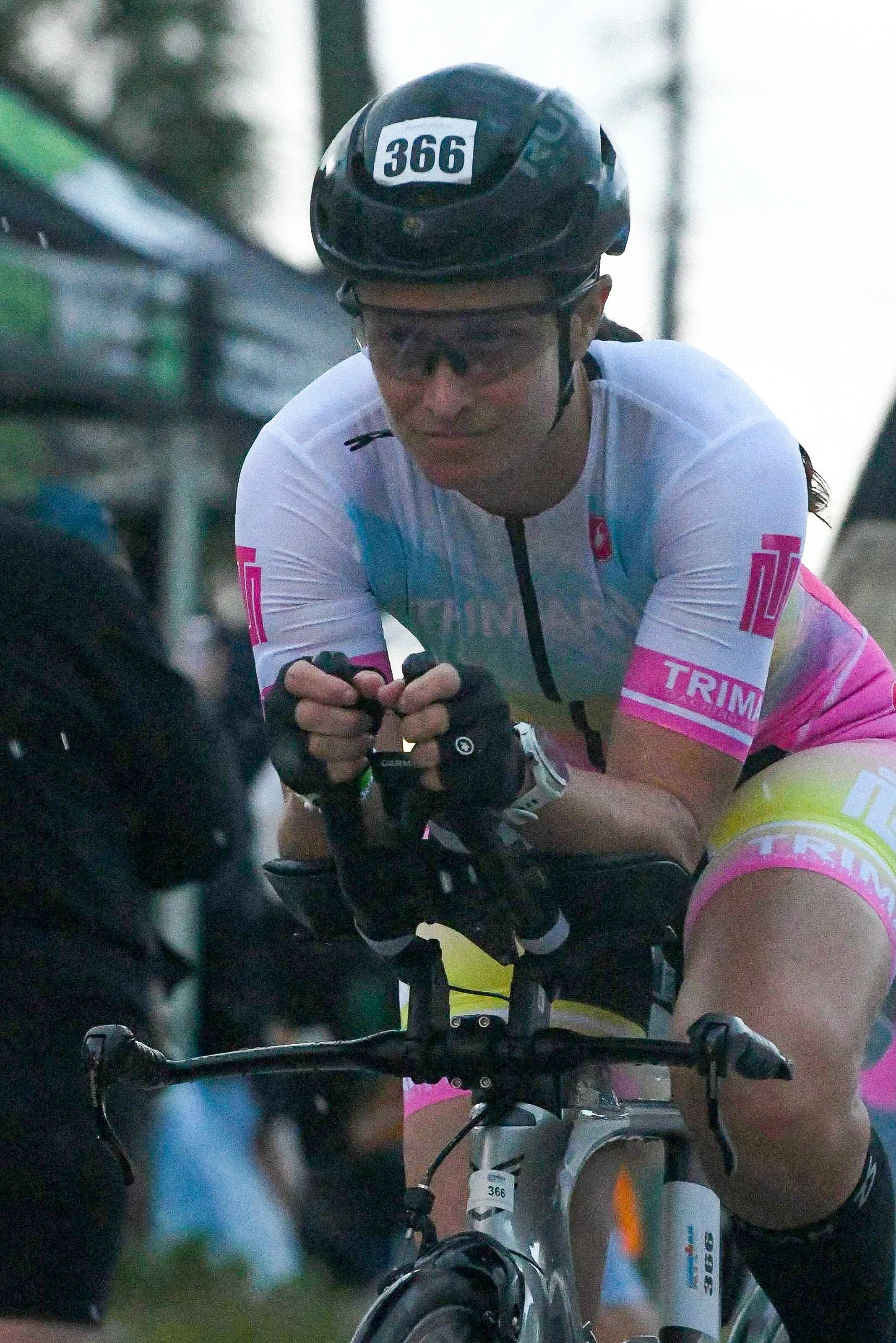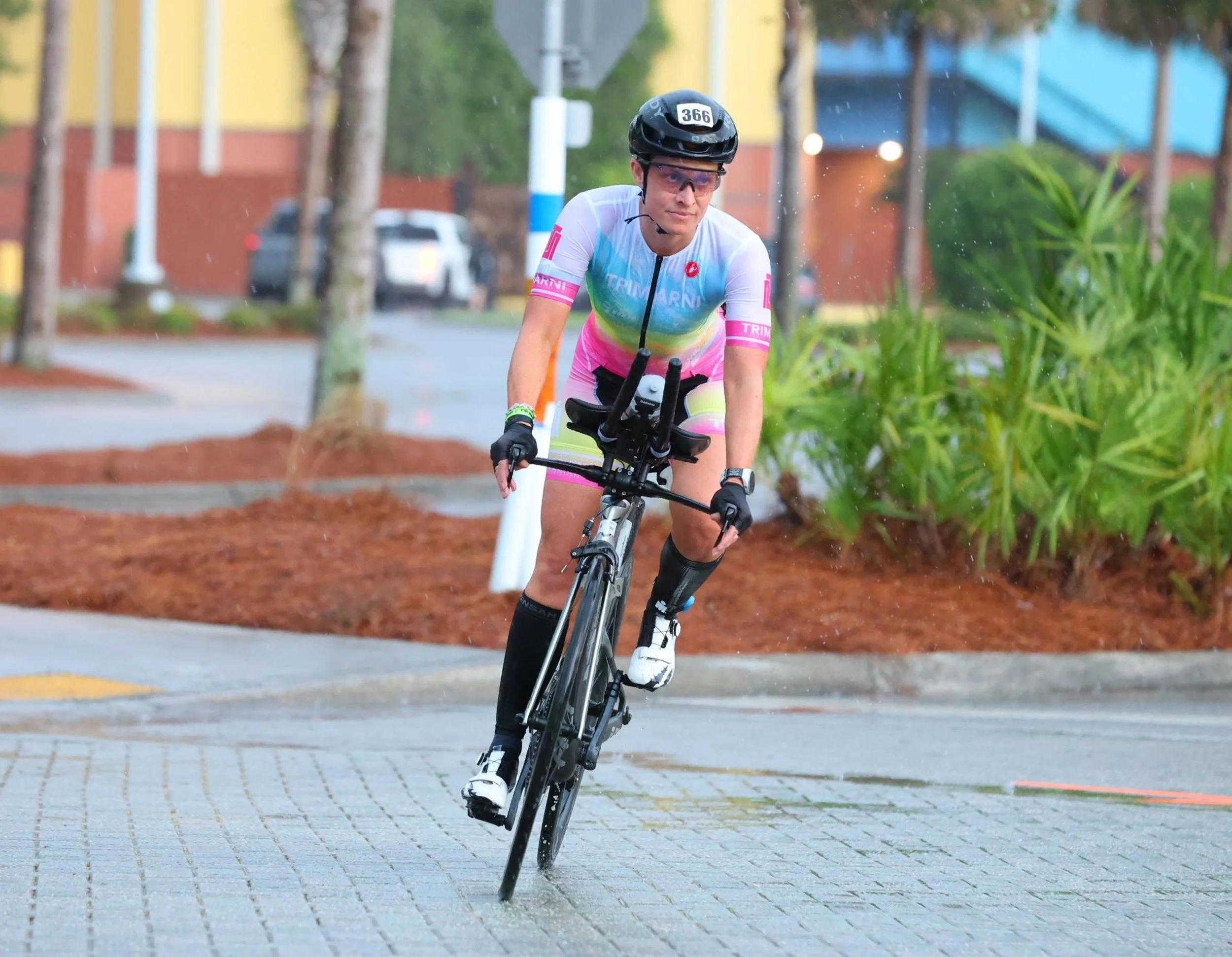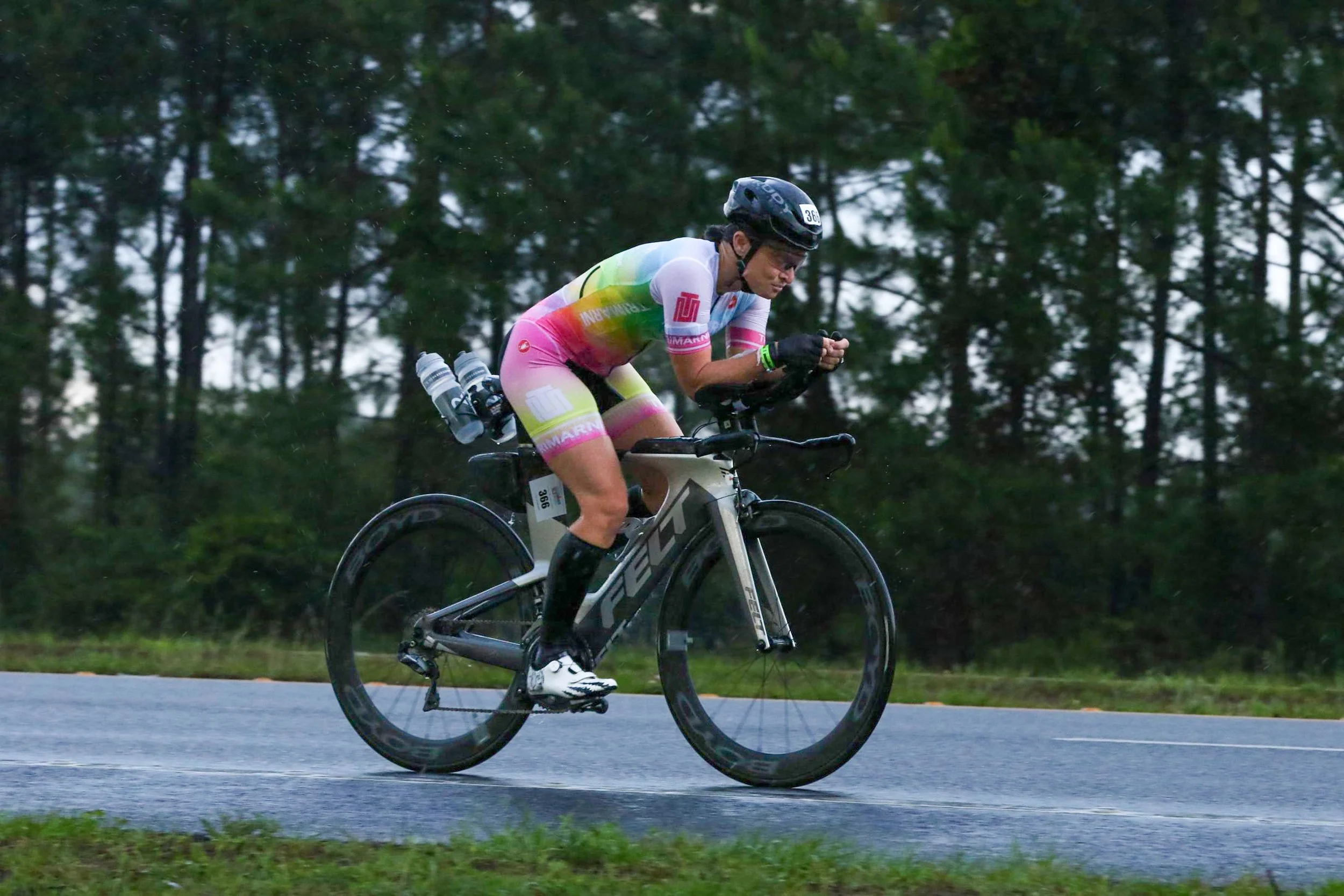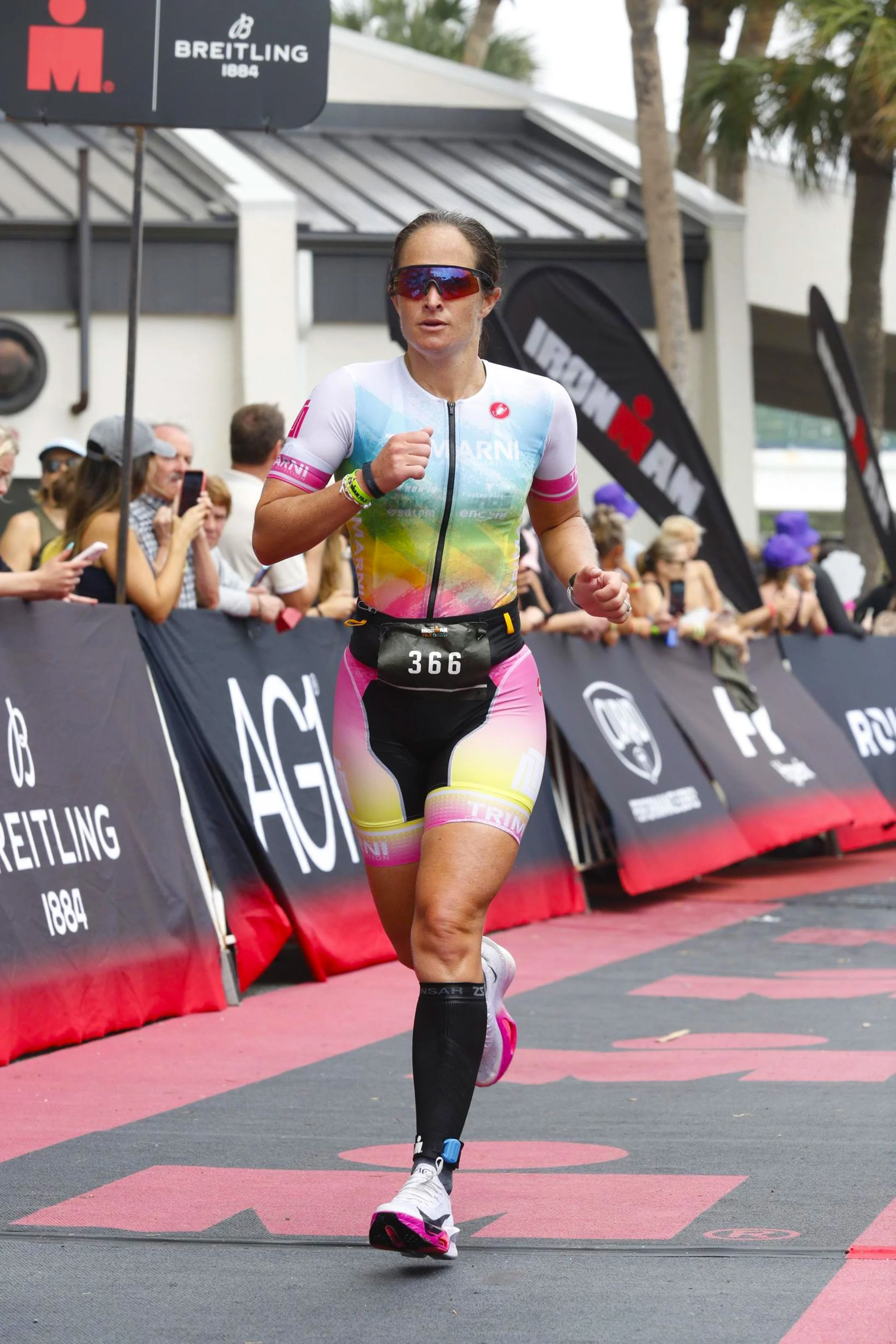Headwind, Hail, and Heat: What 70.3 Gulf Coast Taught Me About Racing Smart in Utter Chaos
How do you respond when everything goes wrong?
As an endurance athlete, it’s an important question to ask, because if it hasn’t happened to you yet, I can guarantee that it will.
This isn’t to scare you. It’s to prepare you.
Because whether it’s a cancelled swim, a flat tire, a dropped bottle, nausea, cramps, or a multitude of other race day curveballs that might get thrown your way, you need to know how you will respond when faced with adversity.
This is my seventh year racing triathlon, so I’ve encountered just about all of the above. But I have to say that nothing quite compares to 70.3 Gulf Coast that took place (kind of, I mean most of it, then it was suspended so…) over the weekend at Panama City Beach.
If you’re new here, I do my race reports a bit differently. Sure, I’m going to tell you about my personal experience, but just talking about myself is boring. I like to include practical takeaways and key strategies that you can use at your next race.
So how do you race smart when the swim gets cancelled, the sky is falling, and there’s rain, hail, heat, and a tornado watch?
Let’s find out.
This is the story of 70.3 Gulf Coast 2025.
It was all going so well…
My husband and I live in Florida, so we’ve spectated at several triathlons in Panama City over the years. I even did my first Ironman there in 2023. But we’ve never raced at 70.3 Gulf Coast. This is mostly because we enjoy doing 70.3 Chattanooga, which is the following week. (Stay tuned for a race preview on Thursday).
But this year, we decided it was time for something new! Leading up to the race, the weather had been unseasonably pleasant, so we knew something was coming. It was either going to be a scorcher, or we’d squeak by with much milder weather than usual for this time of year. But whatever we were expecting, it definitely wasn’t this.
We headed to the race on Wednesday afternoon after doing a swim and run workout at home. We knew there was the potential for bad weather over the weekend, so our coaches suggested packing bike trainers, just in case. (Here’s the packing list Matt and I use for races.)
At our pizza party and team meeting on Thursday, we realized the race would be impacted by weather. We just didn’t know how bad it was going to be.
We talked about what would happen if the swim did get cancelled, how to negotiate a time trial bike start, and tips for safe cycling in the rain. We talked about how no matter what happens, you keep a positive attitude, you keep racing, and you help other athletes who are struggling with disappointment, frustration, ect.
When you put on a race kit, you’re not just an ambassador for the name on your chest, but also for the sport of triathlon as a whole. That means not throwing your sucker in the dirt and having a temper tantrum because things aren’t going as planned.
Sure, it’s a lot easier to say if it’s your 8th 70.3 rather than your first, but the same rules apply. Act right, be kind, and remember there’s still a race to be had.
Some athletes actually get excited when faced with bad weather conditions, because they know it presents a unique opportunity. When the field is so competitive at large races like IRONMAN, even small advantages are very hard to find.
But if you can stay calm, focused, and push through when others get distracted and fall apart, you can have a pretty good day on course.
Race morning: The insanity begins
We woke up at 3 am and followed our typical race morning procedure. I have a bagel with butter and a banana with honey, and Matt has a bagel with 3 scrambled eggs and coffee. Do whatever works for you, but you must eat something before a 5-7-hour race.
Because we were both racing, our lovely race sherpa was my mom, who was ready and raring to go at 4:30 am, for some reason, so we all walked from the villas across the pedestrian bridge to transition.
Note: If you ever do 70.3 Gulf Coast, the best place to stay is Edgewater Villas. It’s a 5 minute walk to transition, Athlete Village, and the run takes three laps through the community, so it’s perfect for spectators.
We’d practiced in both our wetsuits and swim skins in the weeks leading up to the race, because the water temperature was trending towards not being wetsuit legal. As it turned out, we wouldn’t be needing either of them.
Tip: For USAT races, the threshold for wetsuits is 78°F or lower, but for IRONMAN, age-group athletes may wear wetsuits when the water temperature is up to and including 76.1°F. If the water temperature is above 76.1°F, but less than or equal to 83.8°F, age-group athletes can wear wetsuits, but won’t be eligible for awards. Learn more about wetsuits here.
When we got to transition, we learned the swim had been cancelled due to a small craft advisory for the impending storm.
(People like to say the swim always gets cancelled at 70.3 Gulf Coast, but that’s not true. This was only the 3rd time in over 40 years that the swim has been cancelled, so don’t let it scare you away.)
So what happens now?
When the swim is cancelled at an IRONMAN event, the bike begins with a time trial start. Typically, athletes are grouped into sections based on race number. The announcer will call for each transition row to head to the mount line. We were #365 and #366 so that meant we got to start towards the front.
The race start was pushed back from 5:45 am to 6:15 am so we walked back to our house to chill out for a bit.
TIP: It’s always a good idea to bring a bottle of sports drink with you on race morning. If there’s a delay, you won’t get behind on nutrition.
Because we’d now be wearing bike gear to start the race, I made a few adjustments to my transition set-up. First, we put our running shoes and race belts in plastic grocery bags so they wouldn’t be soaking wet by the time we got back to transition. Matt also added some dry running socks. I put on gloves, which I don’t normally wear during a race, but would be helpful for extra grip in the rain.
As we rolled up to the mount line, the rain started to pour and the wind began to howl.
Get More with the Triple Threat Life Club
Want deeper insights, expert advice, and exclusive perks? Join the Triple Threat Life Club for just $5/month and receive access to:
✅ FREE Tri Smarter, Not Harder Triathlon eBook- Releasing next week!
✅ Monthly expert video calls – Learn from pro triathletes, coaches, industry experts (Securing our speaker for May!)
✅ Exclusive discounts – Save $$$ on gear and nutrition from 13 top brands
✅ Bonus content & resources – Members-only articles, templates, and worksheets
✅ Support independent journalism – Help keep this newsletter going
Click here to sign up for the Triple Threat Life Club today.
Monster headwind, rain, and hail, oh my!
One thing about starting the race on the bike is that you aren’t really warmed up yet. You can do a short jog or some jumping jacks in transition, but the main thing is not to go balls to the wall from the gun. I took a few miles to get into my race position and ease into a rhythm.
In my opinion, there are a few places that can get dangerous during the bike leg of a triathlon: the bike start, aid stations, and the bike dismount. The mount line is always a bit hectic, because of amped up athletes, so pay attention to other people. Aid stations can be problematic, because athletes try to ride too fast through them and sometimes drop bottles. The dismount line can be tricky too, because people are tired at that point and start making mistakes.
For the first part of the ride, my goal was to navigate away from everyone else, stay in my aero position, and push smooth, steady power. The rain was pouring, but I use Rudy Project Turbolence transition lenses that change tint depending on sunlight, so I could see well. It’s always a good idea to wear sunglasses on the bike, because of the risk of flying debris.
I didn’t feel any hail, but Matt and a friend of mine said it was really loud inside their aero helmets.
I saw one of my coaches at the turn onto the main road, and he told me to “Go get it,”which made me laugh. We’ve practiced cornering skills, U-turns, and ways to maintain speed with smart terrain management, so I thought about all those things during the ride.
One side effect of a cancelled swim is that the faster cyclists and slower cyclists get mixed together, because the self-sorting doesn’t happen from the swim. This can get a bit tricky, because you’re riding with some very fast folks who fly by you and less experienced cyclists who ride in the middle of the road and don’t have great bike-handling skills.
I always say “on your left” when passing another athletes, not only as a courtesy, but also so I don’t scare someone and they dart out in front of me. Less experienced athletes don’t always know what this phrase means; they hear the word left and might start moving to the left. Talk to people and let them know where you are and what you’re doing. While your race is important, remember that you aren’t the only one out there.
The rain stopped pretty early on, we had some nice tailwind, and there was a beautiful rainbow as we crossed the bridge and headed back to the beach. This course takes you in the back of a Publix parking lot, which is fun, and into a twisty turny section in a park. This provides an opportunity to get out of your bars and change your position. It felt nice to stretch my back, but it’s a bit tricky so you have to slow down. A guy fell in front of me on the wet rubber mats, so I clipped out and stood for a second, but he was ok.
By the time we got to the last 16 miles, we were headed into a 19 mph headwind, which was brutal. I’ve raced at IRONMAN Arizona in bad headwind and at 70.3 St. George the year the big storm hit, but this was something entirely different. It wasn’t just wind. It was a full-on storm.
Until that point, I’d been averaging a little over 21 mph. So if you’re traveling at that speed, and then faced with a 19 mph headwind, you can imagine how challenging it is to keep moving forward. Think about if you’re riding 17 mph or 15 mph? We also had some crosswind from the beach, which felt like being sand-blasted.
Also, many of the high-rise beach hotels have walk-overs from their parking garages, so this forms a wind tunnel that’s directed right at you! The wind whipped under the bridges something fierce. In the beginning, I stayed in my aerobars, but after it cranked my wheel to the side pretty hard, I decided to stay safe on my hoods. The gusty conditions also made it hard to take in nutrition those last 40 minutes, which definitely impacted the run.
Tips for riding in the rain:
Stay away from painted lines on the road, because they get slick when wet.
If you have rim brakes, you might need to feather the brakes a bit to clear water from the rims so they work properly.
Ride on the road whenever possible, not the shoulder. When it rains, all the debris accumulates on the shoulder, and it’s a good way to get a flat tire.
The run should be better… right?
The last section on the bike took so much energy that I felt pretty empty at the start of the run, so I wasn’t looking forward to running three laps of the course.
As I passed my coaches on the first loop, I received instructions. Stay steady, stay cool, and you’re in the top 10. My first thought was, “I’m not likely to stay there!”
And of course, the sun came out when we got off the bike, which means the heat and humidity cranked up to 10. The temperature was 85° with 80% humidity, so the feels like temperature was 97°.
Why does running in heat and humidity feel so brutal?
Mini science lesson time! Your body cools itself through the evaporation of sweat. But in high humidity, the air is already saturated with moisture so sweating doesn’t cool you down. The sweat just sits on your skin, which causes you to overheat more quickly.
The feels like temperature reflects how hot it actually feels to your body. At a heat index of 97°, the body is under extreme thermal stress already, even at rest. Add running to the mix, and you’re generating even more internal heat that you can’t offload. If you don’t slow down or cool off, your heart rate will spike.
Running at your typical pace will feel very hard, even if you’re well trained.
Now, you’re faced with a big physical challenge, as well as a metal one. Everything feels hard. You can’t pick up your legs. You can’t breathe. You want nothing more than to stop or walk, and sometimes you have to if you want to get to the finish line.
TIP: My aid station procedure is the same for every hot race. Run to the aid station, walk the aid station, two cups of water on the head, and one cup of ice in my sports bra and down the back of my kit. Hold ice in my hands while running. Repeat.
Early on, I knew the run was going to be a struggle so I made a deal with myself. I would pick a spot further down the road, like a street sign or hotel, and make myself run to it before I walked. Then, after my heart rate lowered a bit, I’d repeat the process. It doesn’t result in the fastest overall pace, but at certain point, fast is no longer the main concern. Just finishing is the goal.
Matt running to a half marathon PR!
Even with the heat and humidity, the hardest part of this run was the long stretch on Front Beach Road that we had to do three times. Remember the 19 mph tailwind on the bike? Well, it was still there…
I’m not sure I can accurately describe what it felt like to run into that type of headwind. It was like being soaking wet, running in quicksand molasses, on a treadmill of fire. Yup, that about sums it up.
One of my coaches told me to tuck in behind a taller athlete and rest a bit before trying to pass to the next one. It was that bad. I thought there was no way I could do that section three times.
At this point in the race, I ran next to a guy who looked a bit shellshocked. He said, “There’s just no way I could’ve prepared for this.” I just smiled and thought, of course there was.
This is why we ride in the pouring rain instead of staying indoors on the trainer where it’s warm and dry. It’s why we do two a day workouts even when work is crazy, and we’re exhausted and struggling to find time to clean the house, do laundry, and feed ourselves. It’s why we run and walk and get sick and almost pass out, but keep pushing even though we desperately want to stop.
You know you can do hard things, because you’ve done them before. While you can’t prepare for every scenario, you can train yourself to adapt, push through, and persevere when faced with a difficult situation.
Race aftermath: but wait there’s more!
Once we crossed the finish line, I took a dip in the lagoon pool and chatted with a few of our friends. But the sky was getting darker by the minute, and Matt suspected we wouldn’t have time to get our bikes from transition before another storm band rolled in.
The wind was whipping and the sky was spitting. I felt bad for our friends still out on the run course. After about 20 minutes, it started to die down, but a tornado watch had been issued so nobody was allowed in transition. There was a “shelter in place” order for athletes on course (how, I mean literally where are they supposed to take shelter?) and the race was paused.
We waited back at our house for an hour before they opened transition. When we got there, it looked like a tornado had hit. It hadn’t, but the high winds had strewn our gear all over the place.
Also, there was no transition rack for our row, and both of our bikes were lying on the ground tangled together. I wasn’t particularly happy about this, because these bikes are very expensive. If athletes are still on course, transition should be open so we can protect our gear by getting it out of harm’s way.
Thankfully, a nice bike mechanic was able to help us separate the bikes, and with the exception of a few scratches, nothing was broken. But with the tornado watch, they had to stop the race. Basically, this meant athletes still on course would be routed to the finish line turn when they reached it on their current lap.
After a hot shower and some food, our crew headed to get ice cream, because we deserved it!
Despite the wacky conditions, Matt and I both placed pretty high in our age groups. I was 11th and he was 12th. It was the best power I’ve held on a bike for a 70.3, and he had a half marathon run PR (no idea how he did that!) Turns out about half of the athletes in my age group didn’t finish, either because they quit or were pulled from the course. In Matt’s age group, 67 athletes either didn’t start or didn’t finish.
Today, we received an email that due to the unusual circumstances at the race, we get 50% off registration for any open IRONMAN or 70.3 here in the US for 2025. We’ve already registered for all our races this year, but it’s a very nice gesture that they didn’t have to do. (Read the fine print when you sign up.)
I don’t believe in perfect races.
Sure, there are races where everything goes right (but those are few and far between). Even then, there’s always something you could’ve done differently, done just a bit better.
After all, that’s what keeps us coming back, isn’t it?
That’s why you strive, and fight, and push, and struggle. It’s why you expend every last bit of physical and emotional energy you have left to run down the red carpet, collapse across the finish line, and the next day you’re signing up to do it all over again.
Because you want to push your limits, to see what’s possible, to find out how much better, stronger, and faster you can become.
That’s why we do triathlon.
For the continuous pursuit of self-improvement.
So even if you never experience a race like this one, I hope you can take some of the strategies I used and incorporate them at your next event.
Have you ever experienced a race like this? Tell me your story in the comments.


















